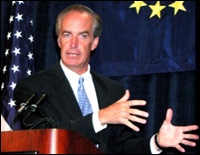The rumor mill is churning fast as Interior Secretary Gale Norton prepares to bid adieu to the Bush administration, and two names on the short list of possible replacements are leading the pack: for an outside-the-Beltway pick, Dirk Kempthorne, Republican governor of Idaho; for an inside-the-agency pick, Lynn Scarlett, currently Norton’s No. 2, who will likely run the department anyway until a permanent replacement is secured.
“This administration has done things two ways when it comes to nominations,” observes Frank Maisano, a lobbyist for the energy industry. “They find a high-profile person outside Washington who can be easily confirmed, carry his own water, and lift the profile of the agency” — think Christine Todd Whitman, the former New Jersey governor who served as Bush’s first EPA administrator — “or the under-the-radar administrative person who can make the trains run on time, is an effective manager, and has the respect of agency staffers” — think current EPA administrator Stephen Johnson.
Whichever course the Bush administration chooses in this case, it’s a safe bet that the outcome will be business as usual.
The White House likely has no intention of changing its drill-and-dig agenda at Interior — on the contrary. Last Friday, after Norton tendered her resignation, President Bush hailed her as “a strong advocate for the wise use and protection of our nation’s natural resources.”
It was a surprisingly unabashed reference to the Wise Use movement launched in the 1980s, whose anti-environmental architects (including Norton, a Colorado native) hailed from the West and pushed an industry-backed agenda calling for privatizing national parks, drilling in wilderness spots including the Arctic National Wildlife Refuge, and logging in roadless areas including Alaska’s Tongass National Forest — pretty damn close to Interior’s agenda during Norton’s tenure.

Lynn Scarlett: moving up in Interior?
Photo: DOI.
“We will be looking West” to find a replacement for Norton, White House Chief of Staff Andy Card told The Denver Post. “She came to the job with a real appreciation of Western lands. … We will be looking for people who have the same appreciation.”
So appreciative was Norton as to oversee a 22 percent boost in coal production on (largely Western) U.S. public lands during her tenure, and a 17 percent increase in natural-gas production.
What other Westerners would be faithful to this trend? The names circulating include Marc Racicot, former Republican governor of Montana, head of the Republican National Committee, chair of the Bush-Cheney reelection campaign, and lobbyist for energy, mining, and timber interests (need we say more?).
Also, Scott McInnis, who represented Colorado’s rural 3rd district in the U.S. House from 1993 to 2005. McInnis is characterized by David Hayes, deputy secretary of Interior under Clinton and now an attorney with the D.C. firm Latham and Watkins, as “a very, very aggressive promoter of a pro-development and anti-federal agenda … on par with [Richard] Pombo,” the notorious chair of the House Resources Committee and environmental foe.
Then there’s James Hansen, the former Republican member of Congress from Utah, whose lifetime voting score from the League of Conservation Voters is a grand 8 out of a possible 100, and who once, as an alternative to the Endangered Species Act, proposed the Human Protection Act, which would prioritize the demands of commerce over the survival of endangered creatures.
Also on the shortlist are Colorado Gov. Bill Owens (R) and Wyoming Sen. Craig Thomas (R), both a few shades more moderate than the other possibilities, but nevertheless opposed by enviros in their home states and known for their longtime support of the Wise Use agenda.
Last but not least is former Colorado Sen. Ben Nighthorse Campbell, who was first elected as a Democrat in 1992 but switched parties after Republicans won control of Congress in 1994. A Native American, he is now a lobbyist for Native American affairs at the D.C.-based law firm Holland & Knight. Sen. Pete Domenici (R-N.M.), chair of the Energy Committee, which is responsible for initial approval of the Interior nominee, said at a press conference yesterday that Nighthorse Campbell would be easy to get confirmed. “We can’t just get somebody who will take a year to get through,” he said.
A Dirk in Progress
Still, topping the list is Kempthorne, who is ripe for the picking: Nearing the end of his second term as Idaho’s governor, he’s a former senator who has been passed over for administration posts (including EPA chief) in the past, as well as an ambassadorship, gives the appearance of being moderate, and has a long history of developing policy on land management. “He has more stature than any of the other picks on the shortlist,” says Hayes. “He’s a force to be reckoned with — he has a very strong voice on Interior matters, has been a big influence on Norton, and would be a very interesting pick.”

Could Dirk Kempthorne fill Gale Norton’s shoes?
Photo: State of Idaho.
In 1997, Kempthorne worked with Sen. John Chafee (R-R.I.) and Interior Secretary Bruce Babbitt to propose modifications to the Endangered Species Act that even some enviros characterized as reasonable and forward-thinking. “A number of organizations including Environmental Defense recognized this 1997 effort as a moderate and commendable compromise on ESA,” says Hayes, adding that Kempthorne “would probably be the easiest of the lot to get a Senate confirmation.”
That said, Kempthorne has also been a longtime proponent of exploiting natural resources on federal lands — drilling in the Arctic Refuge and on the outer continental shelf, and logging in roadless areas of national forests. And as a governor, Kempthorne appears to have been moving rightward in his environmental policies, adapting to the current polarized political scene after the moderate ’90s.
Justin Hayes, program director of the Idaho Conservation League, says Kempthorne has been an “outspoken critic of the ESA, pushing Gale Norton to let states implement their own species-management programs and shift that authority away from Washington.”
Rob Vandermark, director of the Heritage Forests Campaign, adds that Kempthorne has become a “poster child for anti-roadless rule efforts.” The highly protective rule put in place by the Clinton administration has, under Bush, been replaced with one that effectively lets governors decide whether to keep roads out of pristine national-forest areas in their states.
“Kempthorne has allowed the logging industry to wield a very heavy hand in the public comment process on roadless implementation in Idaho,” says Vandermark, “and seems inclined to turn the fate of … wilderness areas over to industry interests.” That’s particularly concerning, he says, given that Idaho contains the most roadless forests in the Lower 48, and the last U.S. ecosystem outside of Alaska that still contains all of its component species.
Dave Alberswerth of the Wilderness Society says there’s little doubt that Kempthorne would come down on the same side as Norton on the major issues now on the table at Interior: changes to National Park Service policy that could allow increased use of snowmobiles, jet skis, and off-road vehicles; the push to substantially expand drilling on the outer continental shelf; and the plan to sell off 125,000 acres of Bureau of Land Management land and as much as 200,000 acres of Forest Service land in order to plug holes in federal funding for rural schools and roads.
Then again, “Kempthorne is not a yes-man,” says David Hayes, “so it’s possible that he could surprise us — acting, say, as a counterweight to the aggressive moves by Pombo to completely undercut ESA.”
This is more than enviros could expect from Lynn Scarlett, a staunch libertarian who has been one of the leading architects of the Bush administration’s environmental agenda, and has argued that the invisible hand of the marketplace “has a green thumb.“
“Any way you slice it,” says Alberswerth, “the outlook is not good.”
